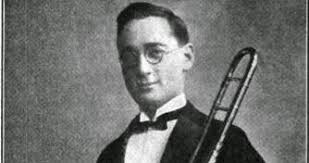
Sam Lewis
*1897
Sam(my) Lewis was born in Boston, Massachussets on 1897. According to the article about Sam(my) Lewis from the May 1921 issue of Jacobs' Band Monthly (via the Yankee Jazz Beat blog run by George A. Borgman), "he [Sam(my) Lewis] was placed in an orphan asylum [with 4 years old] known as the Leopold Morse Home in Mattapan, Mass., his mother, upon the death of his father, having decided to leave the boy in the care of this institution. At this age music did not bother the youngster much, and it was not until his eighth year that music entered into his young life. At this time an alto horn was introduced to "Sammy." The institution had also organized a brass band from among its inmates and Sammy became one of its members. One lesson on this alto horn to the boy, and into the band he went. But Sam quickly became dissatisfied. He wanted to be on the beat and not after it, so in a week's time he was given a cornet and placed on the eighth chair — Sam personally told me that this business of starting on the eighth is an absolute fact. Lewis' ability soon brought him up to the solo cornet chair, where the work held his enthusiastic interest. The two following years are very pleasant memories in Sammy's mind to this day — not alone because of his connection with the band of that institution, but also on account of the many friendships which he formed during the happy days he spent there. The bandmaster in particular, Mr. Emil Posselt, was one of Mr. Lewis' nearest friends. His kindness to the boys and girls who came under his care made them feel toward him as if he were their own parent. At the age of thirteen years, and much to his regret, Sam was transferred from this institution to the English High School in Boston, and it was while attending this school that (as previously stated) he took up the study of the slide trombone under the able tutorship of Mr. Modeste Alloo in that city. Mr. Lewis now aspired to become a symphony man. To travel this road was no easy task, and in order to accomplish it he was compelled to work five hours a day after school in a wholesale men's furnishing place. There he did everything, from running errands to keeping books, and for which he received the munificent sum of five dollars per week — this money helping towards the support of his mother. The work did not bother Sam in the least. He had but one thing in his mind, and that was to play trombone and to play it well. This one absorbing ambition was greatly inspired and aided through Mr. Alloo's kindness. Not only did he teach the young man trombone, but also gave him his initial knowledge of harmony, solfeggi and tympani — this was done mostly to give Lewis a good ear training. Besides giving up many precious hours to help the boy's advancement, Mr. Alloo also furnished him with a trombone upon which to study. One can readily comprehend the magnitude of the unselfish interest bestowed upon Sam Lewis by Mr. Alloo, when it is taken into consideration that all the knowledge gained through this man by Sam was given without any compensation whatsoever. After graduating from the English High School Sam came to New York City, where he secured a position on trial in a moving-picture theatre. The trial proved a success, for it was six months before he got out of there. The Olympic Theatre in Brooklyn, a vaudeville house, was the next stopping place, where another six months was spent. After sixteen months of this sort of work in different theatres around New York, he decided to give up that end of the business and make another effort to gain the goal of his ambition, which was to play music for music's sake. A glowing advertisement appeared in one of the daily newspapers, in reference to an organized band over in the town of Morris Plains in New Jersey. The advertisement told all about the wonderful tuition, free board, laundry, etc., and nothing to do but play in the band and practice. It looked like heaven to him, but being at low ebb financially it took his last remaining dollar to secure a ticket to the town where this organization was located. Upon his arrival in Morris Plains Lewis encountered a shock that will remain clear in his memory throughout his life — the band was made up of the attendants in an insane hospital, the home of the mentally unsound. Being financially embarrassed he was compelled to remain, although considerably scared and decidedly uncomfortable. The following morning another shock came, for he was ordered into the violent ward. I will relate his experience in this violent ward in his own words, which are taken from a letter I received from Lewis some time ago: "My duty was to see that no harm befell these poor creatures, but between you and me I wasn't worrying much about what happened to them! At the end of eight hours I left the ward — pale-faced, dripping with sweat and shaking like a man with the St. Vitas Dance. My hopes were shattered, for the only playing I did there was a weekly rehearsal along with two dances a week, and very little time to practice. The band consisted of twenty such attendants as myself. After four months of this I decided to leave before I, like the others, should start talking out of my turn and be taken for a product of Brazil." Back to New York came Lewis, and many substituting engagements came his way which gave him an insight into all branches of the musical and theatrical business. After a short time he returned to Boston, because of his mother who had been taken ill, and soon after his arrival there he was engaged by Charles Frank to play at the Boston Theatre. This was in 1918, and it was while playing with Mr. Frank that he received an offer from Mr. Earl Fuller in New York City, where at that time Mr. Fuller and his orchestra were all the rage. Lewis accepted the engagement and returned to New York, where Mr. Fuller placed him in Rector's Restaurant at 48th Street and Broadway, and where Sam Lewis learned the gentle art of jazzing and playing artistically for the dance end of the music profession. After a sixteen-weeks' engagement at Rector's, his work there and at individual engagements with different leaders soon became the talk of the town — so much so, that such prominent leaders in this branch of the business as Joseph C. Smith and Mike Markels were quick to grasp the value of Sam's artistic playing and between these two men he had little time that he could call his own, for they kept him a very busy man. The phonograph companies were the next ones to inquire about Sam's work, and it was not long before his services were in demand for the phonograph records. His work is now recorded with the following phonograph companies: The Victor, Columbia, Emerson, Aeolian, Paramount, Starr, Jones, Arto, Puritan, Pathe, Okeh, Edison, and the Gray Gull of Boston, Mass. The records are made with the following orchestras and leaders who are engaged by the companies mentioned: Benny Selvin, Joseph C. Smith, Rudy Wiedoeft, Bennie Krueger, Nicholas Orlando, Max Fells, Sam Lannon, Earl Fuller, Chris Chapman, Hazay Natzy, Oscar Adler, Jules Levy, Jr., Julius Lensberg and Paul Whiteman. After playing for a season or so with the many different leaders in New York City, Mr. Hazay Natzy, musical director at the Hotel Biltmore in New York, tendered Mr. Lewis an exceptional contract which was accepted. Then, fresh from their Western triumphs, Paul Whiteman and his world-famous orchestra came to town, and Mr. Whiteman's trombonist had decided to hand that director his resignation. Of course Mr. Whiteman was compelled to accept the resignation, but the important question with which Mr. Whiteman was confronted was — where to find another man! Good fortune now smiled upon the man who had always experienced the joy of doing a thing well, for it was Sammy Lewis who was sought for the job. The outcome of it all is, as I have previously stated, that Sam Lewis has signed a contract which has two years to run, and which makes him a member of one of the greatest dance orchestras in this country — known as "Paul Whiteman and his Orchestra." This organization is composed of men who are musicians of the highest standard, and with their work Mr. Whiteman has proved himself to be in the dance world what Heifitz is to the violin world —A Genius [...]". Lewis stayed with Paul Whiteman And His Orchestra from late November of 1920 to after the September 12 of 1923, & it was during his stay with Whiteman that he developed his signature crazy trombone style of hot playing. After that, Lewis got the opportunity to join in full time Ben Selvin's orchestra, with whom he stayed until between late 1927 & early 1928. It was during that period that Sam(my) Lewis also recorded with Louis Katzman, Bennie Krueger, Nathan Glantz, Bob Haring, Sam Lanin, Harry Reser & many others. From 1937, he played trombone with the NBC Symphony Orchestra headed by Arturo Toscanini. Nothing is known after Lewis's stay other that he corresponded with Brian Rust, Joseph W. Freeman & other discographers by providing information of recordings on which he played.
